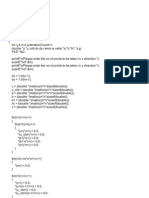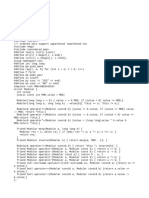Ecc 2
Ecc 2
Uploaded by
sakshi bhegadeCopyright:
Available Formats
Ecc 2
Ecc 2
Uploaded by
sakshi bhegadeOriginal Title
Copyright
Available Formats
Share this document
Did you find this document useful?
Is this content inappropriate?
Copyright:
Available Formats
Ecc 2
Ecc 2
Uploaded by
sakshi bhegadeCopyright:
Available Formats
Name: Siddhant Kundlik Thaware
Class: TY-CS-D
Roll No:34
Date: 6/9/23
Prn No:12110937
Batch: 2
ASSIGNMENT-5:
ELLIPTIC CURVE CRYTOGRAPHY:
Code:
#include <assert.h>
#include <stdlib.h> //rand
#include <time.h> //for srand
#include <functional> //require c++11
#include <iostream>
using namespace std;
class G {
public:
G() {} // Default constructor
// Constructor with parameters to initialize the object
G(const int& x, const int& y, const int& p, const int& a) {
this->x = x, this->y = y, this->a = a, this->p = p;
}
// Overloaded '+' operator for adding two points on an
elliptic curve
G operator+(const G& g) const {
assert(this->a == g.a); // Ensure both points are on the
same curve
int t, xr, yr;
if (this->y == 0)
return G(g.x, g.y, this->p, this->a);
else if (g.y == 0)
return G(this->x, this->y, this->p, this->a);
else if (this->x == g.x && this->y == -g.y)
return G(this->x, 0, this->p, this->a);
else if (this->x == g.x && this->y == g.y)
t = mod(3 * this->x * this->x + this->a, this->p) *
inv(2 * this->y, this->p);
else
t = mod(g.y - this->y, this->p) * inv(mod(g.x - this-
>x, this->p), this->p);
t = mod(t, this->p);
xr = mod(t * t - this->x - g.x, this->p);
yr = t * (this->x - xr) - this->y;
yr = mod(yr, this->p);
return G(xr, yr, this->p, this->a);
}
// Overloaded '-' operator for subtracting two points on an
elliptic curve
G operator-(const G& g) const {
return *this + G(g.x, -g.y, this->p, g.a);
}
// Overloaded '*' operator for scalar multiplication of a
point on an elliptic curve
G operator*(const int& n) const {
G g = *this;
for (int i = 1; i < n; i++)
g = g + *this;
return g;
}
int x, y, p, a; // Public parameters of the point
private:
// Helper function to compute the modular inverse of a number
int inv(const int& num, const int& mod) const {
auto exgcd = [](const int& a, const int& b, int& g, int&
x, int& y) {
std::function<void(const int&, const int&, int&, int&,
int&)> exgcd;
exgcd = [&](const int& a, const int& b, int& g, int&
x, int& y) {
if (!b)
g = a, x = 1, y = 0;
else
exgcd(b, a % b, g, y, x), y -= x * (a / b);
};
return exgcd(a, b, g, x, y);
};
int g, x, y;
exgcd(num, mod, g, x, y);
return ((x % mod) + mod) % mod;
}
// Helper function to compute the modulo of a number
int mod(const int& num, const int& mod) const {
return (num % mod + mod) % mod;
}
};
// Overloaded '*' operator for scalar multiplication with the
scalar on the left-hand side
G operator*(const int& n, const G& g) {
return g * n;
}
class Elliptic_curve {
public:
// Constructor to initialize the elliptic curve parameters and
a base point
Elliptic_curve(const int& a, const int& b, const int& q, const
G& g) {
set(a, b, q, g);
}
// Setter function to update the curve parameters and base
point
void set(const int& a, const int& b, const int& q, const G& g)
{
this->a = a, this->b = b, this->q = q, this->g = g;
}
// Function to generate a random private key in the range [1,
q-1]
int getPrivateKey(const int& q) const {
return (rand() % (q - 1)) + 1; // Random number between 1
and q-1
}
// Function to compute the public key corresponding to a
private key
G getPublicKey(const int& privateKey, const G& g) const {
return privateKey * g; // Scalar multiplication of the
base point
}
// Function to encrypt a message given sender's private key,
receiver's public key, and message point
pair<G, G> getEncryptedMessage(const int& senderPrivateKey,
const G& receiverPublicKey, const G& message) const {
G c1 = senderPrivateKey * g; //
k*G
G c2 = message + senderPrivateKey * receiverPublicKey; //
Pm + k*Pb
return {c1, c2};
}
// Function to decrypt an encrypted message given the pair of
points and the receiver's private key
G getDecryptedMessage(const pair<G, G>& encryptedMessage,
const int& receiverPrivateKey) const {
return encryptedMessage.second - receiverPrivateKey *
encryptedMessage.first; // C2 - nb*C1
}
private:
int a, b, q;
G g; // Base point on the elliptic curve
};
int main() {
int q = 11, a = 1, b = 6;
G g(2, 7, q, a);
Elliptic_curve ec(a, b, q, g);
int nb = 7;
G pb = ec.getPublicKey(nb,g); // Compute the public key for
receiver nb
cout << "pb=" << pb.x << "," << pb.y << endl;
int na = 3;
G pm(10, 9, q, a); // Define the message point Pm
pair<G, G> cm = ec.getEncryptedMessage(na, pb, pm); //
Encrypt the message for receiver pb
cout << "cm1=" << cm.first.x << "," << cm.first.y << endl;
cout << "cm2=" << cm.second.x << "," << cm.second.y << endl;
G pm1 = ec.getDecryptedMessage(cm, nb); // Decrypt the
message using the receiver's private key
cout << "pm=" << pm1.x << "," << pm1.y << endl;
return 0;
}
Output:
You might also like
- Digital Twin-The Simulation AspectDocument16 pagesDigital Twin-The Simulation Aspectjwpaprk1100% (4)
- SE C Graphics ProgramDocument8 pagesSE C Graphics Programsuhas_sna0% (1)
- Lecture 2Document26 pagesLecture 2ashodhiya14No ratings yet
- Intro To Pogramming: TED UET Mardan CampusDocument26 pagesIntro To Pogramming: TED UET Mardan CampusSajid AliNo ratings yet
- Graphics Lab BCA35LDocument15 pagesGraphics Lab BCA35Lapi-3732063No ratings yet
- MessageDocument6 pagesMessagetiger55024No ratings yet
- Digital Signature AlgorithmDocument10 pagesDigital Signature AlgorithmsandipNo ratings yet
- Vivere Ingegneria: TypedefDocument3 pagesVivere Ingegneria: TypedefDomenico MereuNo ratings yet
- GRAPHICS FILE (Harshita)Document63 pagesGRAPHICS FILE (Harshita)Nitasha sharmaNo ratings yet
- Extended gcd-067Document4 pagesExtended gcd-067infinitescientist7No ratings yet
- Task IntermediateDocument15 pagesTask Intermediateelnahassahmed34No ratings yet
- #Include #Include #Include #Include Using NamespaceDocument3 pages#Include #Include #Include #Include Using NamespaceIndra SinagaNo ratings yet
- TemplateDocument6 pagesTemplateishangoyal2658No ratings yet
- Program Reasoning Lab Manual Part1Document11 pagesProgram Reasoning Lab Manual Part1Shubham GargNo ratings yet
- Permanent CPPDocument4 pagesPermanent CPPAyush rishuNo ratings yet
- Lab 16Document43 pagesLab 16Điệp CaoNo ratings yet
- Poisson Equation SolverDocument6 pagesPoisson Equation Solversiva_ksrNo ratings yet
- Extended Euclids AlgorithmDocument3 pagesExtended Euclids Algorithmrehna haseenaNo ratings yet
- InputDocument30 pagesInputSuraj MhaskeNo ratings yet
- CGMT Practical - FileDocument27 pagesCGMT Practical - FilePurva SukhwalNo ratings yet
- Grupa 11 2 Sedinta2Document4 pagesGrupa 11 2 Sedinta2Andrei Rares ChitimusNo ratings yet
- Important OOPs NotesDocument20 pagesImportant OOPs Notesrehan raoNo ratings yet
- OSagedDocument9 pagesOSagedzeyad.hany2003No ratings yet
- CG Practical FileDocument41 pagesCG Practical FileMohit Kumar AgarwalNo ratings yet
- SushillabDocument16 pagesSushillabLord GamerNo ratings yet
- Oops Lab FileDocument28 pagesOops Lab Fileaman shadNo ratings yet
- Program #1 Implementation of Line Generation Using DDA AlgorithmsDocument27 pagesProgram #1 Implementation of Line Generation Using DDA AlgorithmsRahul SrivastavaNo ratings yet
- Mini Project (Hard Copy)Document24 pagesMini Project (Hard Copy)Rizwan HassanNo ratings yet
- CS2405 Computer Graphics Lab ManualDocument60 pagesCS2405 Computer Graphics Lab ManualSonia DudleyNo ratings yet
- Q6 Digital Signature With ECCDocument9 pagesQ6 Digital Signature With ECCAravind krishnaNo ratings yet
- All HPC ProgramsDocument16 pagesAll HPC Programsaditya kambleNo ratings yet
- Q5 ECC Without LibraryDocument4 pagesQ5 ECC Without LibraryAravind krishnaNo ratings yet
- IncludeDocument6 pagesIncludeHhhh Hhhh Hhh HhhhNo ratings yet
- DAA Lab ProgramsDocument56 pagesDAA Lab Programssmdfaizan8147No ratings yet
- HPC OutputDocument12 pagesHPC OutputShubham RokadeNo ratings yet
- Cryptography and Network Security: Practical FileDocument22 pagesCryptography and Network Security: Practical FileanxenaNo ratings yet
- NTC FileDocument63 pagesNTC FilebbbbbbbNo ratings yet
- Exercise - 13 (Applet) : B) To Display Analog Clock Using AppletDocument3 pagesExercise - 13 (Applet) : B) To Display Analog Clock Using AppletTeja Saini TirumalaNo ratings yet
- C (Jan-2010)Document328 pagesC (Jan-2010)Shahebaz WandrickNo ratings yet
- Topic - Distance Vector & Link State Routing ProtocolDocument18 pagesTopic - Distance Vector & Link State Routing ProtocolPREETI -No ratings yet
- PracSolutiondocx 1Document50 pagesPracSolutiondocx 1Varun NairNo ratings yet
- 22CS3048_RISHABH_TRIPATHI_Algo_LAB8Document11 pages22CS3048_RISHABH_TRIPATHI_Algo_LAB8Gautam kumarNo ratings yet
- RSA CodingDocument4 pagesRSA CodingKaniha KNo ratings yet
- CG CodesDocument19 pagesCG CodesAnjali shindeNo ratings yet
- String Concatenation Using Dynamic Memory Allocation ConceptDocument32 pagesString Concatenation Using Dynamic Memory Allocation Conceptapi-3830748No ratings yet
- BookshelfDocument5 pagesBookshelffionaloser7734No ratings yet
- Isma Ainul AmanahDocument8 pagesIsma Ainul Amanahisma ainulNo ratings yet
- CGRDocument32 pagesCGRTausifk871No ratings yet
- Perfectly Balanced Chapter 2 Anand Oza Anandoza Source CodeDocument10 pagesPerfectly Balanced Chapter 2 Anand Oza Anandoza Source CodeDjNo ratings yet
- 6614 PDFDocument64 pages6614 PDFArmando WhiteNo ratings yet
- C++ ProgramDocument31 pagesC++ ProgramMani SinghNo ratings yet
- Experiment No. 1: Graphics Mode InitializationDocument51 pagesExperiment No. 1: Graphics Mode InitializationNitika GuptaNo ratings yet
- CPP All ProgramsDocument94 pagesCPP All ProgramsRishi Khan100% (1)
- Analysis and Design of Algorithm Practical FileDocument21 pagesAnalysis and Design of Algorithm Practical FilemeghaNo ratings yet
- NhanchiadtDocument5 pagesNhanchiadtThanh TranNo ratings yet
- Dynamic Range Minimum QueriesDocument4 pagesDynamic Range Minimum Queriesshripadabhinav.01No ratings yet
- Tugas-GKV-A-1-24060119130071-Jeremy Edbert WidjajaDocument30 pagesTugas-GKV-A-1-24060119130071-Jeremy Edbert WidjajaJeremyNo ratings yet
- Travel Salesman ProblemDocument4 pagesTravel Salesman ProblemTimes UpNo ratings yet
- CS2405 Computer Graphics Lab - Manual: Bresenham's Line Drawing EX NO.1 (A) AimDocument58 pagesCS2405 Computer Graphics Lab - Manual: Bresenham's Line Drawing EX NO.1 (A) AimArpita ChoudharyNo ratings yet
- CS2405 Computer Graphics Lab - Manual: Bresenham's Line Drawing EX NO.1 (A) AimDocument58 pagesCS2405 Computer Graphics Lab - Manual: Bresenham's Line Drawing EX NO.1 (A) AimAvInash KumArNo ratings yet
- Spreadtab enDocument27 pagesSpreadtab enRiccardo Della SalaNo ratings yet
- Pulsar NS200 & AS200 BSIII BSIV Combined - SPCDocument106 pagesPulsar NS200 & AS200 BSIII BSIV Combined - SPCgastonNo ratings yet
- HP Laptops King PDF FreeDocument89 pagesHP Laptops King PDF FreeSwayamvar vermaNo ratings yet
- ABAP HANA - Gensoft TechnologiesDocument2 pagesABAP HANA - Gensoft Technologiessravan100% (1)
- Compact Heat ExchangerDocument4 pagesCompact Heat ExchangerDanish BaigNo ratings yet
- UiARD DemoDocument9 pagesUiARD Demosagar batraNo ratings yet
- TDS - Advance 4T AX5 Scooter 10W-30 (MB)Document2 pagesTDS - Advance 4T AX5 Scooter 10W-30 (MB)hanafiajaNo ratings yet
- Guidelines For ParentsDocument10 pagesGuidelines For ParentssofiabloemNo ratings yet
- MV Spares 2019 CatalogueDocument64 pagesMV Spares 2019 CatalogueAbhishek RaiNo ratings yet
- Rev03Document66 pagesRev03Juan Carlos MolinaNo ratings yet
- Project Report Guidelines 23-24Document12 pagesProject Report Guidelines 23-24Samyak TelmoreNo ratings yet
- Thesis AtakanDocument101 pagesThesis Atakanearth friendlyhqNo ratings yet
- Deployment Guidelines For CDGC, CDQ, CDP, and CDMPDocument75 pagesDeployment Guidelines For CDGC, CDQ, CDP, and CDMPOrachai TassanamethinNo ratings yet
- UpworkDocument26 pagesUpworkHajraaNo ratings yet
- InstructionalDesignModels 2018Document7 pagesInstructionalDesignModels 2018azhari researchNo ratings yet
- Schema TV Led Samsung 5500 40 Serie: Read/DownloadDocument3 pagesSchema TV Led Samsung 5500 40 Serie: Read/Downloadleonel botes100% (1)
- Puff Iron Model EDocument23 pagesPuff Iron Model EUmar MajeedNo ratings yet
- Internal Audit Vs External AuditDocument2 pagesInternal Audit Vs External AudittrenededupNo ratings yet
- Design and Development of A Reversible PDocument6 pagesDesign and Development of A Reversible PSebastián Alexander Flores OroscoNo ratings yet
- Products & Services: - The Youth - Music Lovers - College StudentsDocument2 pagesProducts & Services: - The Youth - Music Lovers - College StudentsvoodooschildNo ratings yet
- Quaternion Open Risk Platform UserguideDocument194 pagesQuaternion Open Risk Platform UserguideMaxim ShafarostovNo ratings yet
- A5E01428618-03 SITRANS CV en en-USDocument114 pagesA5E01428618-03 SITRANS CV en en-USkhaled.essahliNo ratings yet
- Super Road Blaster ManualDocument4 pagesSuper Road Blaster Manualmartinadan0% (1)
- Customer Project Name Contract No. Quotation List No. Region Site Name Site ID Site Address Coordinate Survey DateDocument9 pagesCustomer Project Name Contract No. Quotation List No. Region Site Name Site ID Site Address Coordinate Survey DateAmir SalahNo ratings yet
- Network DiagramDocument7 pagesNetwork Diagram17190889 MUGGI PUTRA PAMUNGKASNo ratings yet
- Technical Application Papers No.9: Bus Communication With ABB Circuit-BreakersDocument116 pagesTechnical Application Papers No.9: Bus Communication With ABB Circuit-BreakersWilliam SilvaNo ratings yet
- Newton Raphson Method Example-2 F (X) 2x 3-2x-5Document3 pagesNewton Raphson Method Example-2 F (X) 2x 3-2x-5Rashid Abu abdoonNo ratings yet
- StarbucksDocument2 pagesStarbucksAnonymous nfLFi1q1No ratings yet
- Condensed DK124Document3 pagesCondensed DK124titis widyantoNo ratings yet

























































































